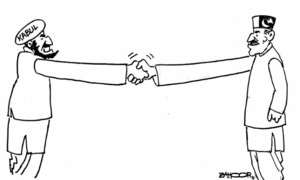
INDIAN WELLS: Serena Williams' return to the top of the world rankings last month at the ripe old age of 31 underlined the shifting landscape at the pinnacle of the women's game.
Not so long ago, teenagers such as Martina Hingis, Jennifer Capriati and Monica Seles dominated the upper reaches of the sport's pecking order but now there is no woman under the age of 20 in the top 10.
Multiple reasons have been suggested for this sea change but, according to former world number one and a child prodigy Tracy Austin, two factors are largely responsible for the transformation.
“First, there is the age eligibility rule,” American Austin told Reuters during a break in her role as a television analyst for Tennis Channel at the BNP Paribas Open being played at Indian Wells.
“Players are not getting as much experience nowadays at a young age. They are kind of slowed down through their path from making that transition from the juniors into the pros because of the limited number of events they are permitted to play.”
The WTA's age eligibility rule prohibits players aged under 14 from competing on the circuit while those aged between 14 and 18 can take part in a limited number of events, rising incrementally.
“I also think that physicality is so great now that it takes a while for some of these younger kids to physically fill out and become strong enough to compete,” Austin said.
“The game is just so much more physically demanding now.”
Teenagers such as Steffi Graf, Seles and Sharapova have often been world number one but, more than a decade after first claiming top spot, 15-times grand slam champion Williams has shown she still thirsts for success.
“To me, Serena looks like she has got another couple of years at least in her,” said Austin, who became world number one for the first time as a 17-year-old in 1980.
“She's an extraordinary athlete and I think because she has had some time off in her career, for extended periods where she was either injured or just away from the game, she still has the hunger.
“She is chasing history now, trying to get to the 18 grand slams that Chrissie (Evert) and Martina (Navratilova) have and that's enticing for her. That's allowed her to stay focused and hungry.”
Only Margaret Court, with 24, Graf (22), Helen Wills Moody (19), Navratilova (18) and Evert (18) have won more women's grand slam singles titles than Williams.
CUPBOARD LOOKS BARE
As and when Williams does decide to end her playing career, the cupboard looks relatively bare when it comes to other American players forcing their way into the top 10, though Austin does see a glimmer of hope.
“I felt like that cupboard was barer a year ago,” said the 50-year-old, who is still living in her native California where she keeps in close contact with the game through her role as a television analyst.
“Now I see the prospect of Sloane (Stephens) and what she is capable of and, coupled with fellow teens Madison Keys and Taylor Townsend, we are starting to see a few more numbers.”
Stephens, aged 19, made a huge splash at the Australian Open in January when she beat Serena Williams in the quarter-finals before losing to the eventual champion Victoria Azarenka in the last four.
However, in the elite WTA event at Indian Wells, Stephens, Keys and Townsend were all knocked out in the second round.
“Sloane has said here that she has been overwhelmed with the expectations since getting into the semis of the Australian but maybe she is just going to take a little bit more time,” said Austin.
“She certainly has huge weapons. But we are used to champions in the United States. We want champions.
“We don't want someone who is top 20, we want someone who is winning grand slams and those are big shoes to fill. When Serena retires, it's going to be a very sad day.”
Asked why the production line of US champions had slowed in recent years, Austin replied: “It's just globalization. Who'd have thought that you would have three players from Serbia, either at number one or winning grand slams in recent years?
“Who would have thought there would be two top women players from Belgium, which is such a small country? The game has become so global now that you have to share the mantle with everybody else.”
Austin, who at 16 became the youngest US Open champion in 1979 before claiming a second US crown in 1981, believes there is only so much the United States Tennis Association (USTA) can do in its bid to unearth future champions.
“The USTA is certainly trying to work on it with the three different training centers, plus the different regional training centers throughout the country,” she said.
“But you look at the champions that have been developed here, most of them have just been developed on their own with their own coaches and they just happened to come through the system.”













































